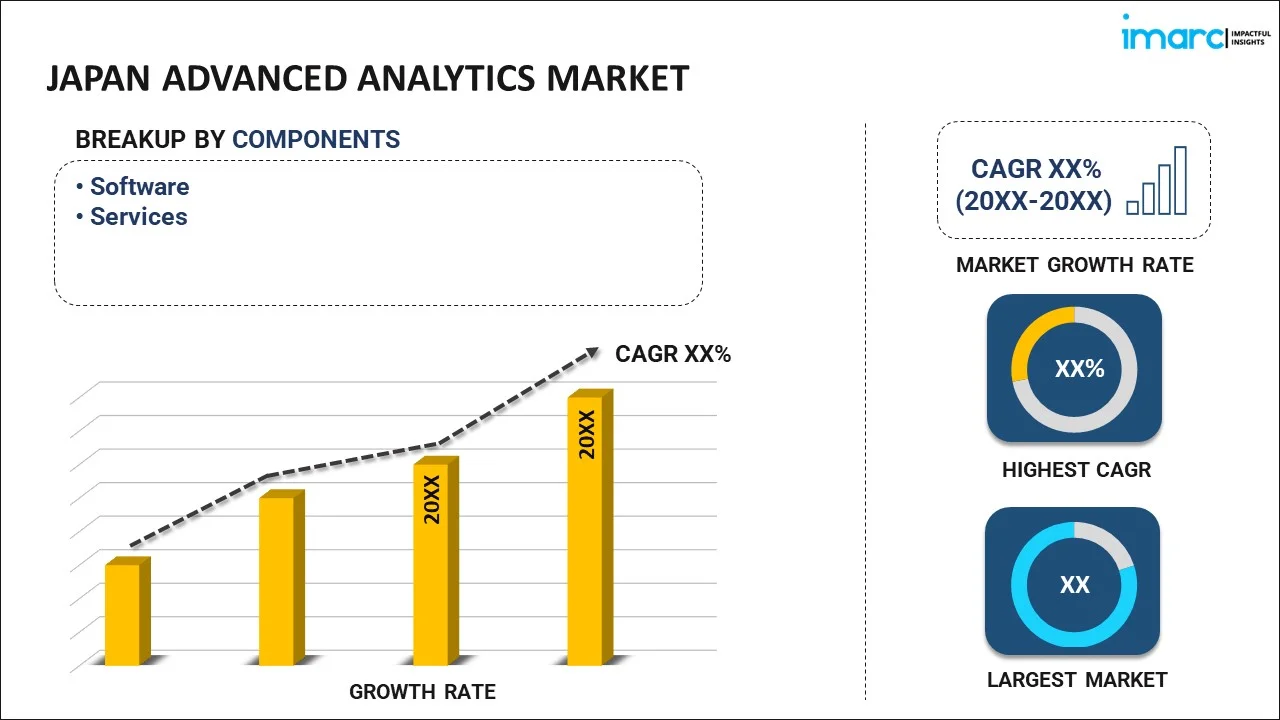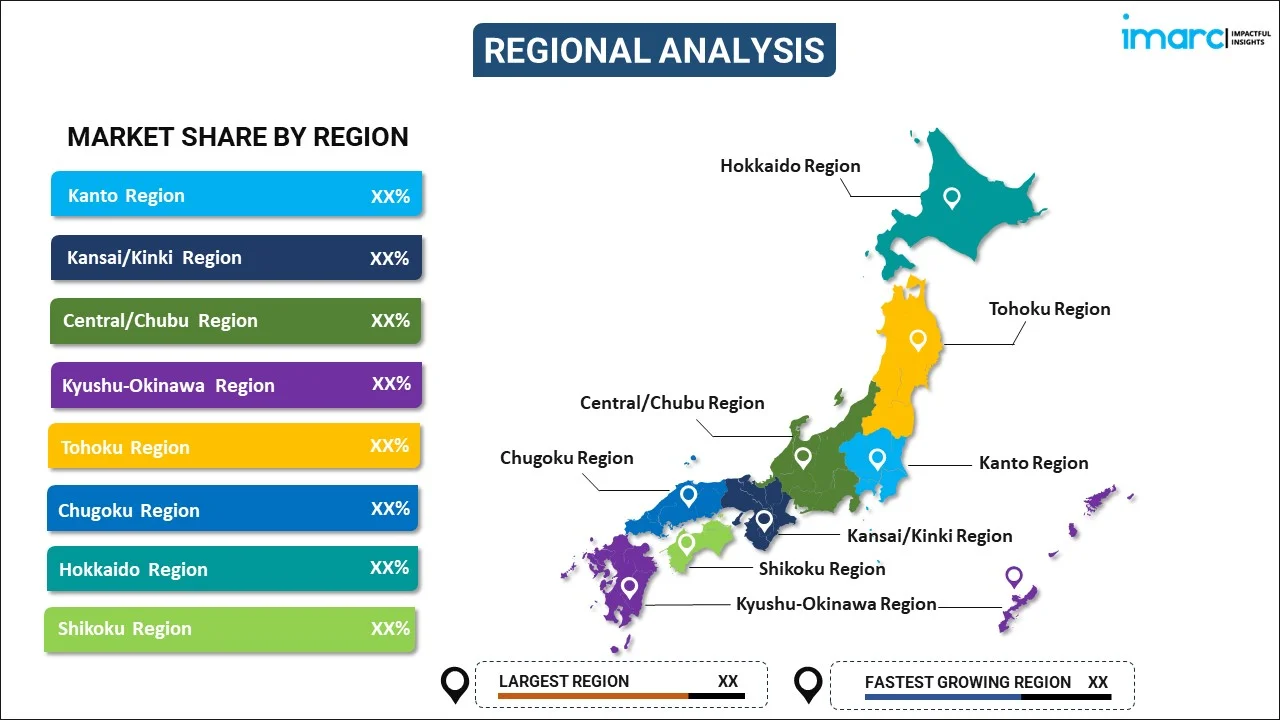
Japan Advanced Analytics Market Report by Component (Software, Services), Type (Big Data Analytics, Business Analytics, Customer Analytics, Statistical Analytics, Risk Analytics, and Others), Deployment Mode (On-premises, Cloud-based), Business Function (Supply Chain, Sales and Marketing, Finance, Human Resource (HR), and Others), Enterprise Size (Large Enterprise, Small and Medium-sized Enterprise), Industrial Vertical (BFSI, Healthcare, Government, IT and Telecom, Military and Defense, and Others), and Region 2025-2033
Market Overview:
Japan advanced analytics market size reached USD 1.2 Billion in 2024. Looking forward, IMARC Group expects the market to reach USD 8.6 Billion by 2033, exhibiting a growth rate (CAGR) of 22.3% during 2025-2033. The market is being driven by a variety of factors, including the growing adoption of analytical solutions across different industries, the increasing demand for artificial intelligence (AI) and machine learning (ML) technologies in corporate settings, and the rising incidence of fraudulent activities within the banking, financial services, and insurance (BFSI) sector.
|
Report Attribute
|
Key Statistics
|
|---|---|
|
Base Year
|
2024
|
|
Forecast Years
|
2025-2033
|
|
Historical Years
|
2019-2024
|
|
Market Size in 2024
|
USD 1.2 Billion |
|
Market Forecast in 2033
|
USD 8.6 Billion |
| Market Growth Rate 2025-2033 | 22.3% |
Advanced analytics is a transformative force that empowers businesses to extract invaluable insights from their data, enabling them to make well-informed decisions and drive growth. Its sophisticated techniques involve the analysis of historical data and the identification of trends, providing the ability to anticipate future outcomes, thus contributing significantly to strategic planning. One of its notable strengths lies in predictive analytics, which enables the forecasting of future scenarios, facilitating proactive problem-solving. Taking this capability further, prescriptive analytics not only predicts but also offers actionable recommendations for optimizing processes and enhancing customer experiences. In the healthcare sector, advanced analytics plays a crucial role in improving patient outcomes by identifying potential risks and proposing personalized treatment plans. In the realm of finance, it aids in fraud detection and risk assessment, ensuring secure transactions. This technology streamlines operations and fosters innovation across various domains, from marketing to supply chain management. In essence, advanced analytics serves as a guiding beacon, illuminating pathways to success and fostering innovation across a spectrum of industries.
Japan Advanced Analytics Market Trends:
The advanced analytics market in Japan is experiencing substantial growth and transformation, driven by several key factors. One of the primary catalysts is the increasing recognition of the immense value that advanced analytics brings to businesses across various sectors. Japanese enterprises are embracing advanced analytics as a transformative force that empowers them to unlock invaluable insights from their data repositories. These insights, facilitated by sophisticated analytical techniques, enable organizations to make data-driven decisions, optimize operations, and drive business growth. In Japan, advanced analytics is not limited to hindsight analysis but extends to predictive and prescriptive analytics, offering organizations the ability to anticipate future trends and challenges while providing actionable recommendations to optimize processes and enhance customer experiences. The integration of machine learning and artificial intelligence (AI) technologies further amplifies the depth and accuracy of analysis, enabling the discovery of hidden patterns and insights that may elude traditional approaches. Various industries in Japan are leveraging advanced analytics to enhance their competitiveness. From marketing strategies to supply chain management, advanced analytics is guiding Japanese businesses towards greater efficiency, innovation, and success. As a result, the advanced analytics market in Japan is poised for continued expansion as organizations increasingly recognize its transformative potential in an era driven by data and digitalization.
Japan Advanced Analytics Market Segmentation:
IMARC Group provides an analysis of the key trends in each segment of the market, along with forecasts at the country level for 2025-2033. Our report has categorized the market based on component, type, deployment mode, business function, enterprise size, and industry vertical.
Component Insights:

- Software
- Services
- Professional Services
- Managed Services
The report has provided a detailed breakup and analysis of the market based on the component. This includes software and service (professional service and managed service).
Type Insights:
- Big Data Analytics
- Business Analytics
- Customer Analytics
- Statistical Analytics
- Risk Analytics
- Others
A detailed breakup and analysis of the market based on the type have also been provided in the report. This includes big data analytics, business analytics, customer analytics, statistical analytics, risk analytics, and others.
Deployment Mode Insights:
- On-premises
- Cloud-based
The report has provided a detailed breakup and analysis of the market based on the deployment mode. This includes on-premises and cloud-based.
Business Function Insights:
- Supply Chain
- Sales and Marketing
- Finance
- Human Resource (HR)
- Others
A detailed breakup and analysis of the market based on the business function have also been provided in the report. This includes supply chain, sales and marketing, finance, human resource (HR), and others.
Enterprise Size Insights:
- Large Enterprise
- Small and Medium-sized Enterprise
The report has provided a detailed breakup and analysis of the market based on the enterprise size. This includes large enterprises and small and medium-sized enterprises.
Industrial Vertical Insights:
- BFSI
- Healthcare
- Government
- IT and Telecom
- Military and Defense
- Others
A detailed breakup and analysis of the market based on the industry vertical have also been provided in the report. This includes BFSI, healthcare, government, IT and telecom, military and defense, and others.
Regional Insights:

- Kanto Region
- Kansai/Kinki Region
- Central/ Chubu Region
- Kyushu-Okinawa Region
- Tohoku Region
- Chugoku Region
- Hokkaido Region
- Shikoku Region
The report has also provided a comprehensive analysis of all the major regional markets, which include Kanto Region, Kansai/Kinki Region, Central/ Chubu Region, Kyushu-Okinawa Region, Tohoku Region, Chugoku Region, Hokkaido Region, and Shikoku Region.
Competitive Landscape:
The market research report has also provided a comprehensive analysis of the competitive landscape. Competitive analysis such as market structure, key player positioning, top winning strategies, competitive dashboard, and company evaluation quadrant has been covered in the report. Also, detailed profiles of all major companies have been provided.
Japan Advanced Analytics Market Report Coverage:
| Report Features | Details |
|---|---|
| Base Year of the Analysis | 2024 |
| Historical Period | 2019-2024 |
| Forecast Period | 2025-2033 |
| Units | Billion USD |
| Scope of the Report | Exploration of Historical Trends and Market Outlook, Industry Catalysts and Challenges, Segment-Wise Historical and Future Market Assessment:
|
| Components Covered |
|
| Types Covered | Big Data Analytics, Business Analytics, Customer Analytics, Statistical Analytics, Risk Analytics, Others |
| Deployment Modes Covered | On-premises, Cloud-based |
| Business Functions Covered | Supply Chain, Sales and Marketing, Finance, Human Resource (HR), Others |
| Enterprise Sizes Covered | Large Enterprise, Small and Medium-sized Enterprise |
| Industrial Verticals Covered | BFSI, Healthcare, Government, IT and Telecom, Military and Defense, Others |
| Regions Covered | Kanto Region, Kansai/Kinki Region, Central/ Chubu Region, Kyushu-Okinawa Region, Tohoku Region, Chugoku Region, Hokkaido Region, Shikoku Region |
| Customization Scope | 10% Free Customization |
| Post-Sale Analyst Support | 10-12 Weeks |
| Delivery Format | PDF and Excel through Email (We can also provide the editable version of the report in PPT/Word format on special request) |
Key Questions Answered in This Report:
- How has the Japan advanced analytics market performed so far and how will it perform in the coming years?
- What has been the impact of COVID-19 on the Japan advanced analytics market?
- What is the breakup of the Japan advanced analytics market on the basis of component?
- What is the breakup of the Japan advanced analytics market on the basis of type?
- What is the breakup of the Japan advanced analytics market on the basis of deployment mode?
- What is the breakup of the Japan advanced analytics market on the basis of business function?
- What is the breakup of the Japan advanced analytics market on the basis of enterprise size?
- What is the breakup of the Japan advanced analytics market on the basis of industrial vertical?
- What are the various stages in the value chain of the Japan advanced analytics market?
- What are the key driving factors and challenges in the Japan advanced analytics?
- What is the structure of the Japan advanced analytics market and who are the key players?
- What is the degree of competition in the Japan advanced analytics market?
Key Benefits for Stakeholders:
- IMARC’s industry report offers a comprehensive quantitative analysis of various market segments, historical and current market trends, market forecasts, and dynamics of the Japan advanced analytics market from 2019-2033.
- The research report provides the latest information on the market drivers, challenges, and opportunities in the Japan advanced analytics market.
- Porter's five forces analysis assist stakeholders in assessing the impact of new entrants, competitive rivalry, supplier power, buyer power, and the threat of substitution. It helps stakeholders to analyze the level of competition within the Japan advanced analytics industry and its attractiveness.
- Competitive landscape allows stakeholders to understand their competitive environment and provides an insight into the current positions of key players in the market.
Need more help?
- Speak to our experienced analysts for insights on the current market scenarios.
- Include additional segments and countries to customize the report as per your requirement.
- Gain an unparalleled competitive advantage in your domain by understanding how to utilize the report and positively impacting your operations and revenue.
- For further assistance, please connect with our analysts.
 Inquire Before Buying
Inquire Before Buying
 Speak to an Analyst
Speak to an Analyst
 Request Brochure
Request Brochure
 Request Customization
Request Customization




.webp)




.webp)












